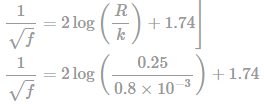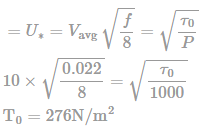GATE Exam > GATE Questions > A 50 cm diameter pipe carries water (v = 0.2...
Start Learning for Free
A 50 cm diameter pipe carries water (v = 0.294 × 10–6 m2/s) at an average velocity of 10 m/s . The roughness of pipe surface is 0.8 mm. For fully rough turbulent flow, What is the boundary shear stress.
- a)275
- b)277
Correct answer is between '275,277'. Can you explain this answer?
| FREE This question is part of | Download PDF Attempt this Test |
Verified Answer
A 50 cm diameter pipe carries water (v = 0.294 × 10–6 m2/s) at an ave...

F = 0.022
Shear velocity

Most Upvoted Answer
A 50 cm diameter pipe carries water (v = 0.294 × 10–6 m2/s) at an ave...
To calculate the boundary shear stress for fully rough turbulent flow in a pipe, we can use the Darcy-Weisbach equation:
𝑓 = (1/√𝑓) + 2 log10((𝜖/𝑅)√𝑓)
Where:
𝑓 = Darcy-Weisbach friction factor
𝜖 = roughness height on the pipe surface
𝑅 = hydraulic radius of the pipe
In this case, we are given the diameter of the pipe, so we can calculate the hydraulic radius:
𝑅 = 𝐷/4 = 50 cm / 4 = 12.5 cm = 0.125 m
Given that the roughness height is 0.8 mm, we need to convert it to meters:
𝜖 = 0.8 mm = 0.8 × 10^(-3) m
Now we can solve the Darcy-Weisbach equation for the friction factor. Since this is fully rough turbulent flow, we assume the friction factor is constant:
𝑓 = 0.02
Next, we can use the friction factor to calculate the boundary shear stress using the following equation:
𝜏 = 𝑓 × (𝜌 × 𝑢^2)/2
Where:
𝜏 = boundary shear stress
𝜌 = density of water
𝑢 = average velocity of water in the pipe
Given that the average velocity is 10 m/s and the density of water is approximately 1000 kg/m^3, we can substitute these values into the equation:
𝜏 = 0.02 × (1000 kg/m^3 × (10 m/s)^2)/2 = 0.02 × 5000 N/m^2 = 100 N/m^2
Converting to Pascal (Pa), we get:
𝜏 = 100 Pa
This is equivalent to 100 N/m^2, and since 1 N/m^2 is equal to 1 Pascal, the boundary shear stress is 100 Pa.
Therefore, the correct answer is not between 275 and 277. The correct answer is 100 Pa.
𝑓 = (1/√𝑓) + 2 log10((𝜖/𝑅)√𝑓)
Where:
𝑓 = Darcy-Weisbach friction factor
𝜖 = roughness height on the pipe surface
𝑅 = hydraulic radius of the pipe
In this case, we are given the diameter of the pipe, so we can calculate the hydraulic radius:
𝑅 = 𝐷/4 = 50 cm / 4 = 12.5 cm = 0.125 m
Given that the roughness height is 0.8 mm, we need to convert it to meters:
𝜖 = 0.8 mm = 0.8 × 10^(-3) m
Now we can solve the Darcy-Weisbach equation for the friction factor. Since this is fully rough turbulent flow, we assume the friction factor is constant:
𝑓 = 0.02
Next, we can use the friction factor to calculate the boundary shear stress using the following equation:
𝜏 = 𝑓 × (𝜌 × 𝑢^2)/2
Where:
𝜏 = boundary shear stress
𝜌 = density of water
𝑢 = average velocity of water in the pipe
Given that the average velocity is 10 m/s and the density of water is approximately 1000 kg/m^3, we can substitute these values into the equation:
𝜏 = 0.02 × (1000 kg/m^3 × (10 m/s)^2)/2 = 0.02 × 5000 N/m^2 = 100 N/m^2
Converting to Pascal (Pa), we get:
𝜏 = 100 Pa
This is equivalent to 100 N/m^2, and since 1 N/m^2 is equal to 1 Pascal, the boundary shear stress is 100 Pa.
Therefore, the correct answer is not between 275 and 277. The correct answer is 100 Pa.

|
Explore Courses for GATE exam
|

|
Similar GATE Doubts
A 50 cm diameter pipe carries water (v = 0.294 × 10–6 m2/s) at an average velocity of 10 m/s . The roughness of pipe surface is 0.8 mm. For fully rough turbulent flow, What is the boundary shear stress.a)275b)277Correct answer is between '275,277'. Can you explain this answer?
Question Description
A 50 cm diameter pipe carries water (v = 0.294 × 10–6 m2/s) at an average velocity of 10 m/s . The roughness of pipe surface is 0.8 mm. For fully rough turbulent flow, What is the boundary shear stress.a)275b)277Correct answer is between '275,277'. Can you explain this answer? for GATE 2024 is part of GATE preparation. The Question and answers have been prepared according to the GATE exam syllabus. Information about A 50 cm diameter pipe carries water (v = 0.294 × 10–6 m2/s) at an average velocity of 10 m/s . The roughness of pipe surface is 0.8 mm. For fully rough turbulent flow, What is the boundary shear stress.a)275b)277Correct answer is between '275,277'. Can you explain this answer? covers all topics & solutions for GATE 2024 Exam. Find important definitions, questions, meanings, examples, exercises and tests below for A 50 cm diameter pipe carries water (v = 0.294 × 10–6 m2/s) at an average velocity of 10 m/s . The roughness of pipe surface is 0.8 mm. For fully rough turbulent flow, What is the boundary shear stress.a)275b)277Correct answer is between '275,277'. Can you explain this answer?.
A 50 cm diameter pipe carries water (v = 0.294 × 10–6 m2/s) at an average velocity of 10 m/s . The roughness of pipe surface is 0.8 mm. For fully rough turbulent flow, What is the boundary shear stress.a)275b)277Correct answer is between '275,277'. Can you explain this answer? for GATE 2024 is part of GATE preparation. The Question and answers have been prepared according to the GATE exam syllabus. Information about A 50 cm diameter pipe carries water (v = 0.294 × 10–6 m2/s) at an average velocity of 10 m/s . The roughness of pipe surface is 0.8 mm. For fully rough turbulent flow, What is the boundary shear stress.a)275b)277Correct answer is between '275,277'. Can you explain this answer? covers all topics & solutions for GATE 2024 Exam. Find important definitions, questions, meanings, examples, exercises and tests below for A 50 cm diameter pipe carries water (v = 0.294 × 10–6 m2/s) at an average velocity of 10 m/s . The roughness of pipe surface is 0.8 mm. For fully rough turbulent flow, What is the boundary shear stress.a)275b)277Correct answer is between '275,277'. Can you explain this answer?.
Solutions for A 50 cm diameter pipe carries water (v = 0.294 × 10–6 m2/s) at an average velocity of 10 m/s . The roughness of pipe surface is 0.8 mm. For fully rough turbulent flow, What is the boundary shear stress.a)275b)277Correct answer is between '275,277'. Can you explain this answer? in English & in Hindi are available as part of our courses for GATE.
Download more important topics, notes, lectures and mock test series for GATE Exam by signing up for free.
Here you can find the meaning of A 50 cm diameter pipe carries water (v = 0.294 × 10–6 m2/s) at an average velocity of 10 m/s . The roughness of pipe surface is 0.8 mm. For fully rough turbulent flow, What is the boundary shear stress.a)275b)277Correct answer is between '275,277'. Can you explain this answer? defined & explained in the simplest way possible. Besides giving the explanation of
A 50 cm diameter pipe carries water (v = 0.294 × 10–6 m2/s) at an average velocity of 10 m/s . The roughness of pipe surface is 0.8 mm. For fully rough turbulent flow, What is the boundary shear stress.a)275b)277Correct answer is between '275,277'. Can you explain this answer?, a detailed solution for A 50 cm diameter pipe carries water (v = 0.294 × 10–6 m2/s) at an average velocity of 10 m/s . The roughness of pipe surface is 0.8 mm. For fully rough turbulent flow, What is the boundary shear stress.a)275b)277Correct answer is between '275,277'. Can you explain this answer? has been provided alongside types of A 50 cm diameter pipe carries water (v = 0.294 × 10–6 m2/s) at an average velocity of 10 m/s . The roughness of pipe surface is 0.8 mm. For fully rough turbulent flow, What is the boundary shear stress.a)275b)277Correct answer is between '275,277'. Can you explain this answer? theory, EduRev gives you an
ample number of questions to practice A 50 cm diameter pipe carries water (v = 0.294 × 10–6 m2/s) at an average velocity of 10 m/s . The roughness of pipe surface is 0.8 mm. For fully rough turbulent flow, What is the boundary shear stress.a)275b)277Correct answer is between '275,277'. Can you explain this answer? tests, examples and also practice GATE tests.

|
Explore Courses for GATE exam
|

|
Suggested Free Tests
Signup for Free!
Signup to see your scores go up within 7 days! Learn & Practice with 1000+ FREE Notes, Videos & Tests.


















